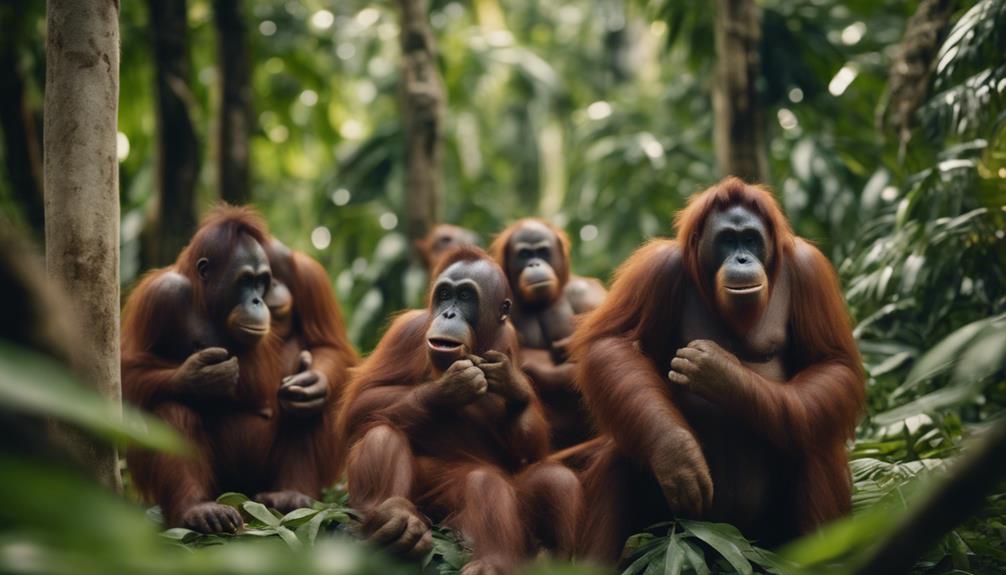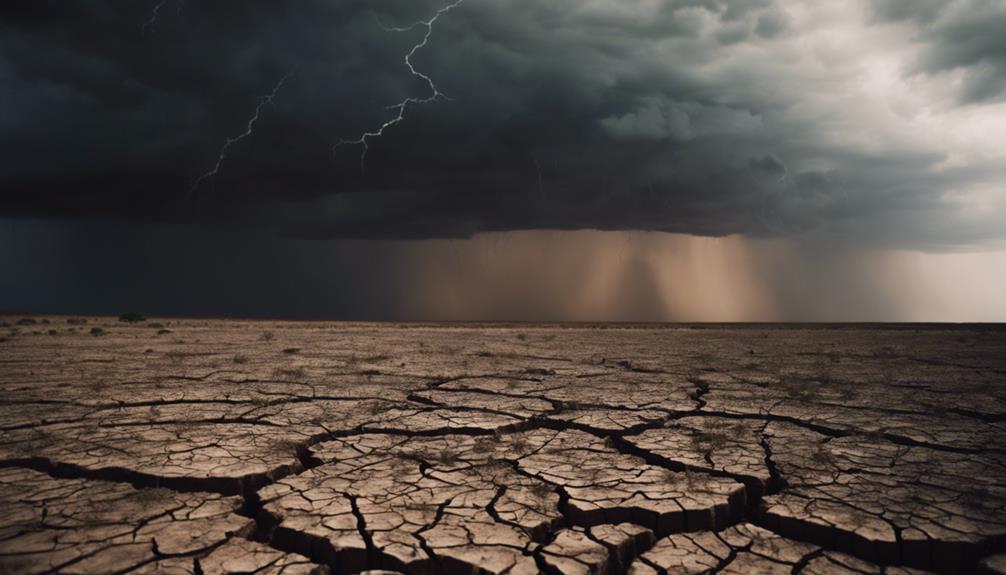Social mingling notably influences how orangutans issue warning calls, showcasing the impact of social dynamics on their communication strategies. Studies reveal that orangutans adapt these calls based on group interactions, reflecting their ability to adjust vocalizations to specific social contexts. Vocalizations vary depending on the intensity of relationships within groups, demonstrating the nuanced ways in which social interactions shape their warning signals. Orangutans exhibit remarkable flexibility in their vocal behaviors, highlighting their intelligence in adapting to the social environment through unique warning calls. Understanding these intricate dynamics provides valuable insights into the complexity of orangutans' communication strategies.
Key Takeaways
- Orangutans adjust warning calls based on social interactions and group dynamics.
- Vocalizations are tailored to specific situations influenced by social relationships.
- Social mingling influences the timing and intensity of warning calls.
- Social bonds play a significant role in shaping how orangutans issue warning calls.
- Social environment impacts the structure and content of orangutan vocalizations.
Social Dynamics in Orangutan Vocalizations
Influenced by their social interactions, orangutans actively adjust their warning calls within groups to reflect the dynamics of their social mingling. Social evolution plays an important role in shaping how orangutans communicate through vocalizations. The adaptation of warning calls based on social interactions highlights the intricate nature of primate behavior and the significance of group dynamics among orangutans.
Within orangutan groups, the frequency and variety of warning calls are influenced by the composition and interactions within the social unit. This evolution in vocalizations showcases the adaptive nature of orangutans in response to their social environment. By using warning calls as a means of communication, orangutans demonstrate how social dynamics can impact their vocal expressions.
Understanding the correlation between social interactions and vocalizations provides valuable insights into the behavior and communication patterns of orangutans. The ability of these primates to adjust their warning calls based on social cues exemplifies the complexity of their social structure and the evolution of their communication methods within groups.
Influence of Social Environment on Calls
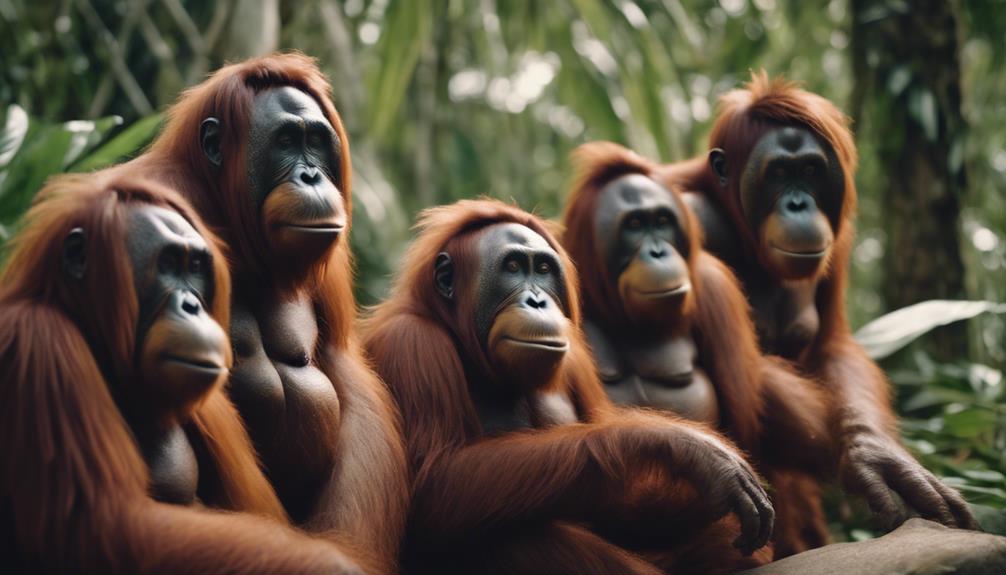
Orangutans adjust their warning calls in response to their social environment, showcasing how communication in groups is influenced by social dynamics.
The intensity and timing of these vocalizations are shaped by interactions within their populations, leading to more diverse and nuanced warning calls in high-density orangutan groups.
This highlights the significant impact of social mingling on how orangutans convey danger signals through their vocalizations.
Social Dynamics and Calls
In high-density orangutan populations, social interactions play a substantial role in shaping how warning vocalizations are issued within the groups. Orangutans in such environments exhibit a higher level of flexibility in their warning call patterns, a behavior directly influenced by the dynamics of social mingling. The way orangutans communicate danger through vocalizations is intricately linked to their social interactions, highlighting the importance of understanding the social dynamics within orangutan groups.
Researchers have observed that in high-density populations, orangutans adjust their warning calls based on the social environment they're in. This adaptation showcases the nuanced ways in which communication is influenced by the social dynamics at play. By studying these behaviors, scientists gain valuable insights into how orangutans navigate their social interactions and issue warning calls in response to potential threats.
The correlation between social dynamics and warning calls in orangutans emphasizes the intricate nature of their communication system, where social interactions significantly shape how danger is conveyed through vocalizations.
Communication in Groups
Communication within orangutan groups dynamically adapts to the social environment, shaping the nuances of their warning vocalizations. Orangutans alter their warning calls based on social interactions, with high-density populations leading to modifications in tone and frequency.
The presence and behavior of other group members influence how orangutans adjust their vocalizations, reflecting the interaction dynamics within the group. These adjustments not only convey the urgency of the situation but also enhance the clarity of the warning signals emitted.
The social environment plays a vital role in how orangutans communicate danger through vocalizations, highlighting the importance of group dynamics in their communication. By being attuned to their surroundings and fellow orangutans, these primates ensure effective communication of potential threats, showcasing the intricate ways in which social interactions shape their vocal communication.
Fundamentally, the collective behavior within orangutan groups impacts the clarity and urgency of their warning calls when faced with danger.
Communication Evolution in Orangutans
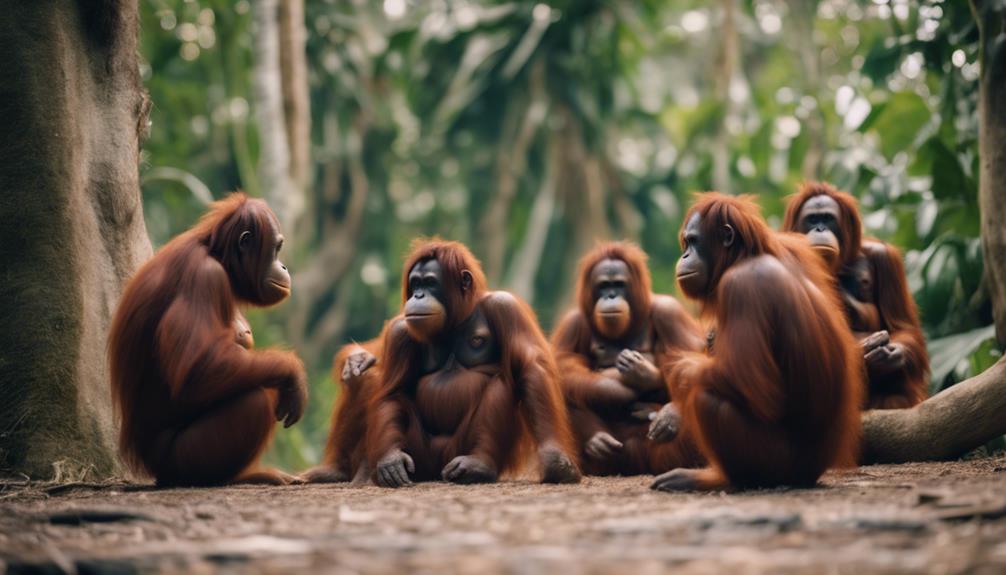
Through their social interactions and group dynamics, the evolution of warning calls in orangutans reflects their adaptive communication strategies. Orangutans adjust their warning calls based on the level of social mingling within their groups.
In high-density populations, where interactions are frequent, orangutans display a diverse range of warning call variations to effectively communicate with one another. On the other hand, orangutans in low-density populations tend to rely more on conventional warning calls, reflecting their less frequent social interactions.
These variations in warning calls demonstrate the impact of social dynamics on the communication evolution of orangutans. By understanding how social interactions shape the way orangutans issue warning calls, researchers gain valuable insights into the evolutionary patterns of communication in these primates.
Studying these communication strategies provides a deeper understanding of how orangutans have adapted their warning calls over time to suit their social environments and ensure efficient communication within their groups.
Social Mingling and Warning Calls
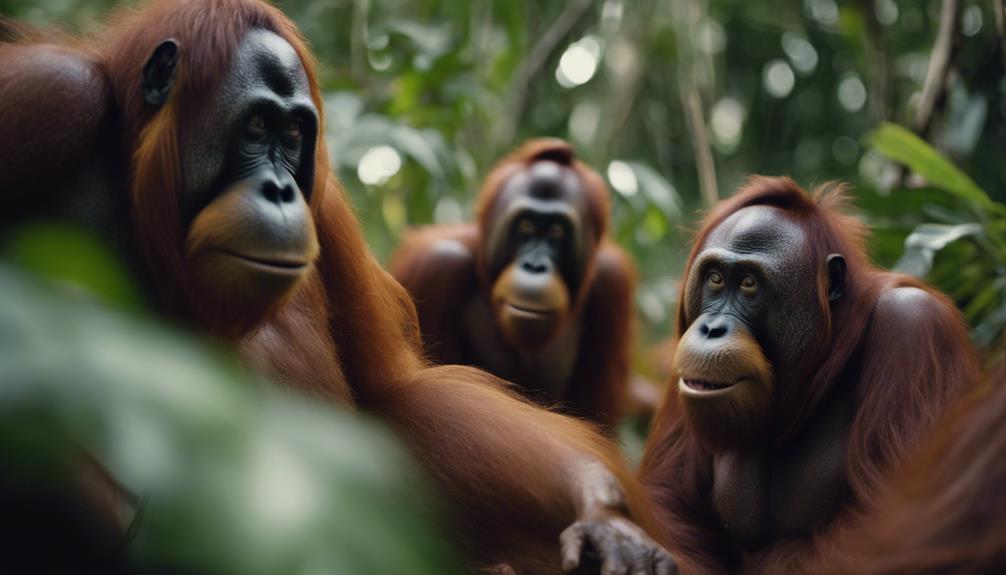
Social interactions greatly influence how orangutans modify their warning calls within their social groups. Orangutans adjust the structure of their warning calls based on their social relationships.
Social mingling plays a vital role in shaping the context and content of orangutans' warning vocalizations. By observing orangutans in their natural habitats, researchers have noted that interactions with other individuals directly impact the timing and intensity of their warning calls.
These vocalizations aren't just random; they're tailored to specific situations, highlighting the intricate communication system within orangutan communities. Understanding how social mingling affects orangutans' warning calls provides valuable insights into their communication behaviors.
It showcases the complexity of their social interactions and how these interactions influence their vocal strategies. By studying these behaviors, scientists can unravel the intricate web of orangutan social dynamics and the role warning calls play in maintaining social cohesion within their groups.
Vocal Strategies in High-Density Populations
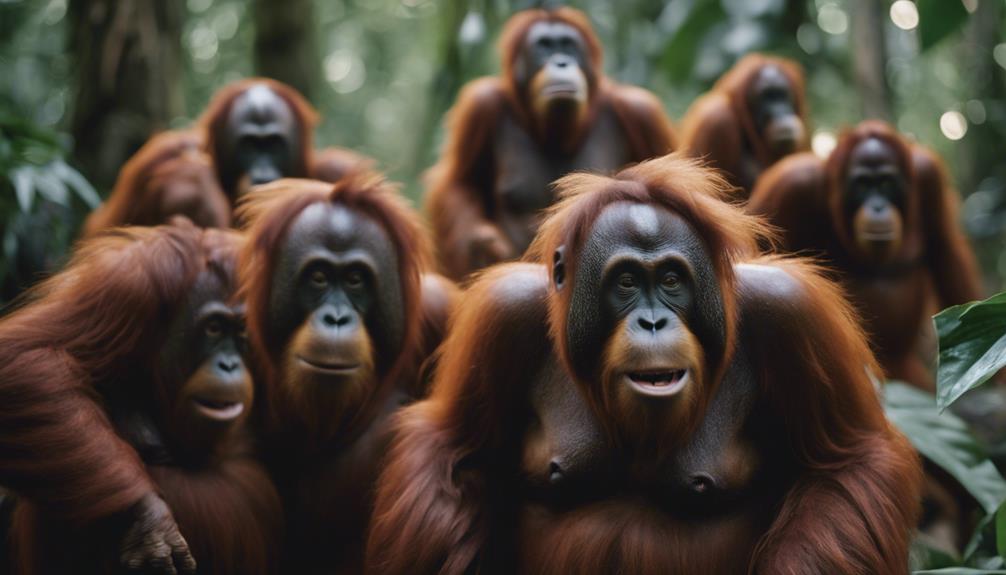
In high-density orangutan populations, vocal warning calls exhibit a diverse range influenced by social interactions. Orangutans in densely populated areas develop unique variations in their warning calls due to the impact of social dynamics. These vocal strategies are shaped by the frequency and nature of social mingling within the population.
The variety of calls reflects the complexities of orangutan vocabularies influenced by their interactions with peers. As a result, orangutans adjust their vocal communication behaviors based on the social cues they receive in high-density settings. Understanding these vocal strategies is essential for comprehending how orangutans navigate their social environment and issue warnings effectively.
The ability to adapt their warning calls based on social interactions showcases the flexibility and intelligence of orangutans in responding to the challenges of living in high-density populations. This highlights the intricate relationship between social dynamics and vocalizations in orangutan communities.
Impact of Social Interactions on Calls
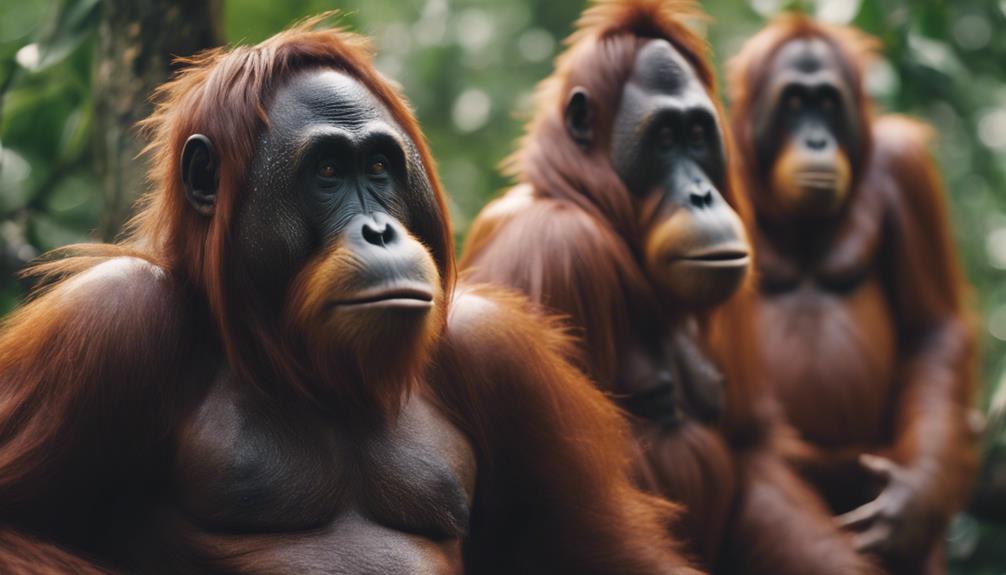
Orangutans' warning calls are greatly influenced by their social bonds, shaping the way they communicate and interact within their groups.
Understanding how social interactions impact orangutans' calls provides valuable insights into their behavior and communication strategies.
This phenomenon highlights the intricate relationship between social dynamics and vocalizations in orangutan communities.
Social Bonds Influence Calls
Interactions among orangutans greatly influence the modification of their warning calls, demonstrating how social bonds shape vocalizations. Orangutans adjust the intensity and frequency of their warning calls based on their social bonds, highlighting the impact of social dynamics on communication.
This adjustment reflects the intricate social structure within orangutan groups, where vocal behavior is a key element of their interactions. The unique warning calls of orangutans are a product of their social mingling, showcasing how social relationships influence vocalizations.
By studying how orangutans issue warning calls, researchers gain insight into the critical ways in which social bonds shape vocal behavior. Understanding the role of social interactions in vocalizations is essential for unraveling the communication patterns of orangutans and their social structure.
Through observing these primates in their natural habitat, scientists can decipher the subtle nuances of their warning calls and the significant role that social bonds play in shaping their communication.
Communication Among Orangutans
Social mingling among orangutans intricately shapes their warning calls, reflecting the profound impact of social interactions on their communication.
Orangutans adjust their vocalizations based on the level of social interactions within their groups. High-density populations exhibit a wider array of warning call variations, showcasing the influence of increased social mingling on communication behavior.
The diverse variations in orangutans' warning calls highlight the role of social dynamics in shaping their vocal communication. Understanding how social forces impact orangutans' warning calls provides valuable insights into their communication among individuals.
Warning Calls and Behavior
The adjustment of warning calls among orangutans reflects the significant impact of social dynamics on their vocal communication. Orangutans modify the frequency and intensity of their warning calls based on their social interactions within the group. Social mingling plays a vital role in shaping the structure and pitch of these vocalizations, with variations observed depending on the orangutans' social relationships. Different social contexts influence the timing and duration of warning calls, highlighting the importance of their communication strategies.
Researchers have observed that 'orangutans exhibit a nuanced understanding of social relationships, which is reflected in their warning calls,' indicating the intricate nature of their vocalizations. By adapting their calls to the social dynamics at play, orangutans demonstrate a sophisticated communication system that's influenced by their interactions with conspecifics. Understanding how social interactions shape warning calls provides valuable insights into the complexities of orangutan behavior and communication strategies in the wild.
Orangutan Vocal Diversity in Groups
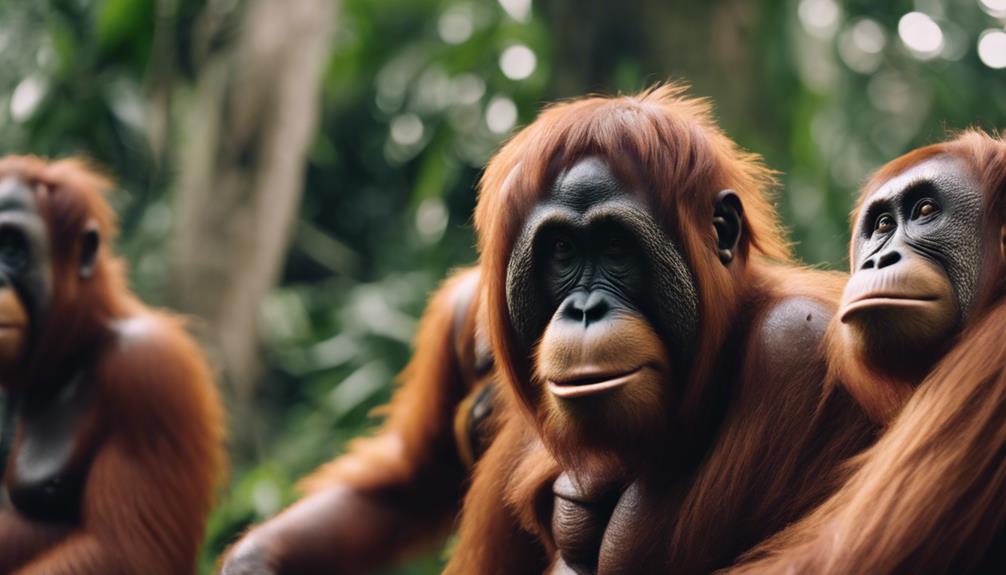
Orangutans in high-density populations showcase a rich array of vocal calls, exhibiting various kiss-squeak variations. In the wild, orangutan populations display vocal diversity influenced by social mingling within high-density groups. Their warning calls serve as a form of crucial communication, shaped by dynamic interactions with others.
Researchers have observed that orangutans modify their vocalizations based on the social environment they're in, experimenting with novel sounds for warning calls. This behavior highlights the flexibility and complexity of orangutan communication systems. Understanding how social mingling affects vocalizations among orangutans provides valuable insights into their intricate social dynamics and communication strategies.
Through these vocal exchanges, orangutans in high-density groups navigate their relationships and convey essential information to one another. The vocal diversity observed in these populations underscores the importance of social interactions in shaping orangutan communication patterns.
Behavioral Adaptations in Vocalizations

In response to varying social cues, orangutans adapt their warning calls to reflect dynamic group dynamics and interactions. The new findings contribute towards understanding how these animals call out in response to different sounds and social contexts.
Orangutans, being apes with advanced cognition and unique verbal skills, exhibit a range of vocalizations that are shaped by their social environment. Researchers analyzed the largest sample ever of orangutans to uncover how these animals adjust their warning calls in different social settings.
By living alongside orangutans and studying their vocalizations, scientists have gained insights into the behavioral adaptations of these apes. The ability of orangutans to modify their warning calls based on social interactions highlights their complex communication strategies.
This understanding sheds light on the intricate ways in which orangutans utilize vocal signals to communicate potential threats within their groups.
Social Environment and Communication Evolution
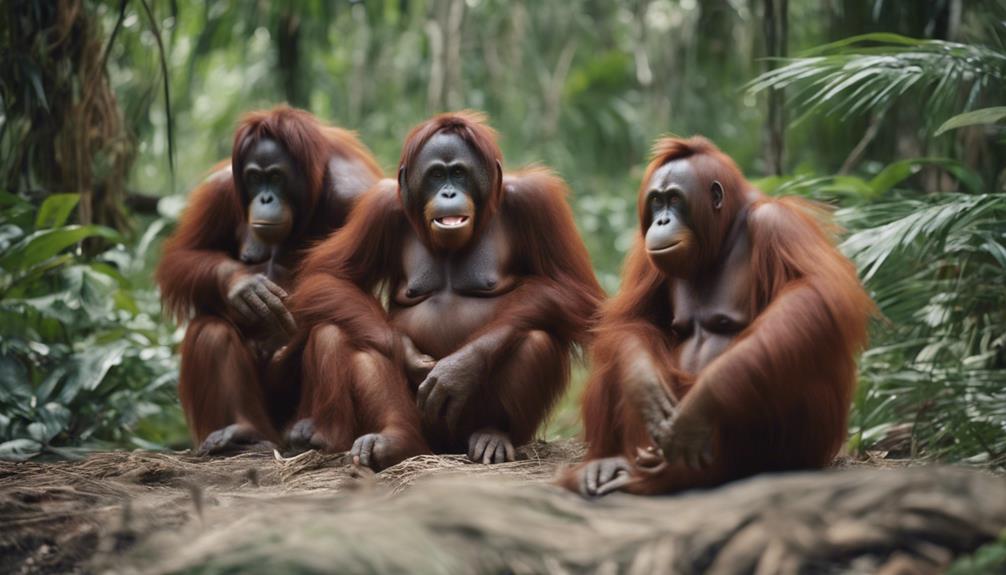
Social mingling among orangutans shapes the evolution of their communication strategies. Researchers lived alongside orangutans in the low rainforests of Borneo and Sumatra to understand how social interactions contribute towards the understanding of orangutan communication.
By studying how these primates lived and interacted, scientists gained insights into the origins and evolution of their communication patterns. According to the study, populations favored more established warning call patterns due to their social environment. This research challenges simplistic explanations for the development of communication in orangutans, from notions of advanced cognition to divine intervention.
The distinct vocal personalities observed in orangutans can be linked to their social dynamics, shedding light on the evolutionary pathways that have shaped their communication behaviors. Understanding the influence of social environments on communication evolution is essential for deciphering the complexities of orangutan vocalizations and how they adapt to the world around us.
Frequently Asked Questions
How Do Orangutans Interact With Humans?
Orangutans interact with humans based on perceived threats and past experiences. They issue warning calls like grunts, barks, or roars to communicate discomfort or set boundaries. Responses vary among individuals, influenced by context and personality. Understanding these calls can prevent conflicts and promote mutual respect.
What Is the Social Life of the Orangutan?
Orangutans have diverse social structures, adapting their communication based on group dynamics. In high-density populations, warning call variations are more varied.
Social mingling influences vocal patterns and how warnings are conveyed. Understanding orangutans' social lives sheds light on their environment navigation and effective communication within groups.
Are Orangutans Aggressive Towards Humans?
Orangutans, in the wild, are generally not aggressive towards humans. They may issue warning calls when feeling threatened. Social mingling among orangutans influences their reactions to human encounters.
If they see humans as a threat, they may exhibit defensive behaviors. Understanding warning calls can help minimize aggressive interactions. This knowledge is vital for fostering peaceful coexistence between humans and orangutans in their shared habitats.
Are Orangutans Social or Solitary?
Orangutans are primarily solitary animals, but they do engage in social interactions during specific periods, such as mating or overlapping home ranges. These social interactions influence how orangutans issue warning calls, adapting to their environment and social dynamics.
Understanding the social aspects of orangutan behavior can provide insights into their communication strategies and group dynamics.
Conclusion
Fundamentally, the social mingling of orangutans plays a vital role in shaping their warning calls. Through interactions with others in their group, these primates develop unique vocal strategies to effectively communicate and navigate their surroundings.
This adaptation highlights the intricate evolution of communication in orangutans, showcasing the importance of social dynamics in their vocalizations. The complexity of their calls reflects the nuanced ways in which these intelligent creatures interact and warn each other of potential dangers.
